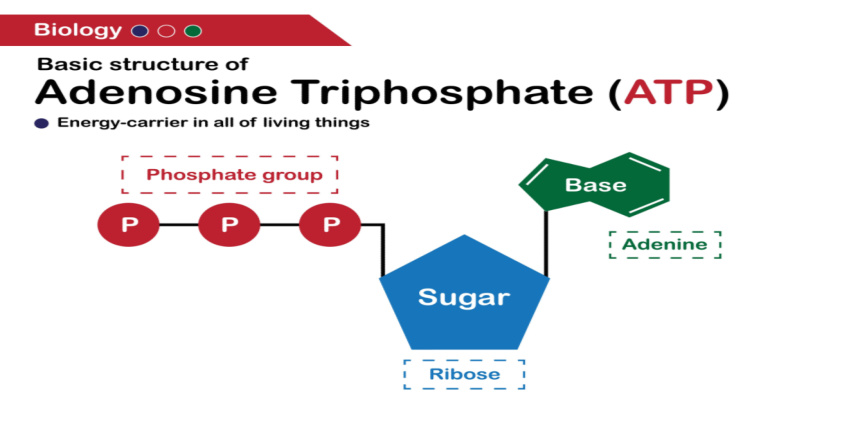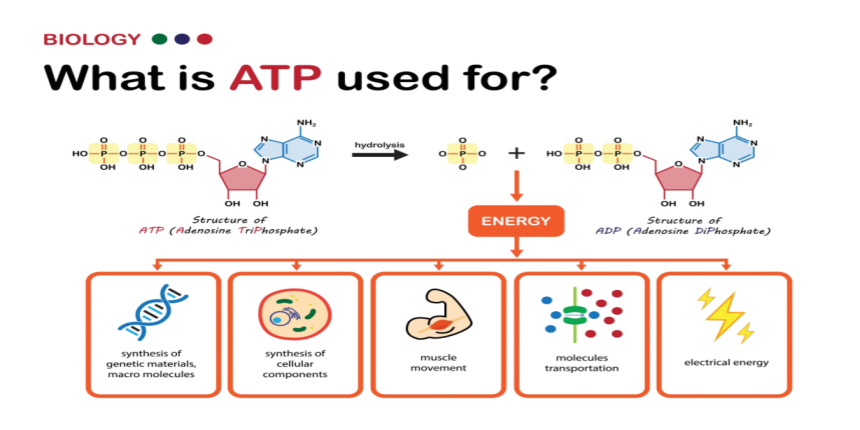ATP Full Form
What is Full Form of ATP ?
ATP: Adenosine Triphosphate
The full form of ATP is Adenosine Triphosphate. Being a complicated organism, the body needs the energy to continue operating properly. Adenosine triphosphate is used and stored as an energy source in cells. ATP is a nucleoside triphosphate with the following structural components: adenine, ribose, and three serially bonded phosphate groups. ATP is often referred to as the "energy currency" of the cell since it saves easily available energy in the link between the second and third phosphate groups.

An average of 32 ATP molecules are produced for every molecule of oxidized glucose during cellular respiration, which takes place mostly in the mitochondrial matrix. Ion transport, muscular contraction, the transmission of nerve impulses, the phosphorylation of substrates, and chemical synthesis are just a few of the processes that use ATP as an energy source. The requirement for ATP is considerable due to these and other processes. The hydrolysis of 100 to 150 moles of ATP every day is, therefore, necessary for the efficient functioning of the cells in the human body.
Structure of ATP
A triphosphate group is then used to form a link between the sugar's 5′ carbon atom and the 9-nitrogen atom of adenine, which is attached to the sugar's 1′ carbon atom. The adenine and sugar groups stay unaltered over their extensive metabolic processes, however, the triphosphate is changed into di- and monophosphate, resulting in ADP and AMP, respectively. Alpha, beta, and gamma are the names of the three phosphoryl groups for the terminal phosphate.
Ionized ATP is primarily composed of ATP4 and a trace amount of ATP3 in a neutral solution.

Various Functions of ATP:
Anaerobic Respiration
Cellular Respiration
ATP in Muscle Contraction
DNA/RNA Synthesis
Neurotransmission
Purinergic Signalling
ATP in Intracellular Signaling
Beta-Oxidation
Clinical significance of ATP:
Cardiology and Surgery
In individuals with pulmonary hypertension, ATP is a reliable and safe pulmonary vasodilator. The blood pressure of a patient can also be lowered during surgery using adenosine and ATP.
Role of ATP in Pain Control
Acute perioperative discomfort has decreased, according to clinical trials on ATP. Patients in these studies received intravenous ATP. Adenosine is administered intravenously, where it interacts with the A1 adenosine receptor and starts a signalling cascade that ultimately helps reduce inflammation-related pain.
Anesthesia
During anesthesia, ATP supplementation provided beneficial results. Evidence suggests that neuropathic pain, ischemic pain, and hyperalgesia are all reduced by low dosages of adenosine.
The ATP Production Process
Only the nutrients we ingest with meals have the power to make the ATP energy molecules active. These cells can function effectively because the nutrients help with their oxidation.
The respiration of the cytosol and mitochondria facilitates the synthesis of ATP. The initial stage of this process is glycolysis, followed by aerobic respiration. 36 ATP molecules are created during three different steps.
In plants, the light and dark reactions involved in photosynthesis are used to make ATP. Sunlight's chemical energy is converted into ATP. The phosphate group then transforms this chemical energy into ATP. The subsequent dark process of photosynthesis, which is necessary for the plant's life, transforms the ATP into glucose.
Benefits of ATP
ATP, which stands for adenosine triphosphate, is crucial for sustaining joint health. ATP protects your joints, especially your knees, by preserving strength and minimizing discomfort.
ATP contributes to an increase in physical energy by giving your body a necessary component for survival.
You may obtain energy from all the nutrients you consume, thanks to ATP molecules. ATP intake is crucial, especially for athletes and anyone who performs heavy lifting daily.
ATP will also take care of your heart rhythm.